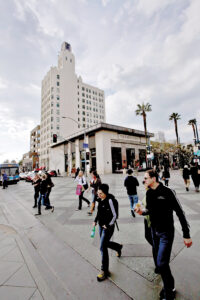
CITY HALL — Community groups called on the City Council Monday to postpone a decision on an environmental analysis of development in Downtown until after a plan for the area has been finished and more council members are present.
The discussion and possible vote scheduled for Tuesday, July 9 will set parameters for what gets studied in an environmental impact report for the Downtown Specific Plan, a half-finished effort that will dictate how the Downtown develops over the next 20 years.
The Program Environmental Impact Report will look at heights, densities and traffic issues caused by development between Ocean Avenue, Interstate 10, Wilshire Boulevard and Lincoln Boulevard, a contentious topic for many Santa Monicans who fear that the city by the sea will turn into the West Coast's version of Miami Beach.
The Santa Monica Coalition for a Livable City and North of Montana Association both sent letters to the City Council raising concerns about moving forward with an environmental report before the plan is finished and what they consider a lack of public process.
"Commencing a (program environmental impact report) at this time, before the city has gone through an orderly process of crafting a Downtown Specific Plan, would rush the process for no apparent public benefit and would have the effect of severely limiting meaningful input of resident stakeholders," the NOMA board wrote to council members.
The proposal, released July 2, has not gone to the Planning Commission, nor will the full council be present to discuss it on Tuesday, wrote Diana Gordon, co-chair of SMCLC.
"The Planning Commission is the body that should normally review this … and offer the council its recommendations," Gordon wrote. "To eliminate such review is a poor use of resources and raises serious questions about the process."
Planning Commissioner Richard McKinnon raised a similar concern last month when he attempted to get the topic up for discussion on July 10 only to find out that the City Council would hear it on July 9.
The Planning Commission will get the opportunity to see the plan in its entirety in December when the draft is expected to be finished, but to do that, the four to five-month long environmental review process needed to get rolling, said City Manager Rod Gould.
"The information that flows from the (environmental impact report) will help with drafting the plan that goes to the Planning Commission," Gould said.
The Downtown Specific Plan is one of several required by the Land Use and Circulation Element, a guide to the next 20 years of Santa Monica development that was adopted almost exactly three years ago. As proposals for development continue to flow into City Hall, it becomes increasingly important to finish the Downtown Specific Plan and others like it, Gould said.
"The rules of the game should be clear and agreed to before we go any further in approving development agreements," he said.
City officials recommended few changes to much of the Downtown, even lowering heights in some places and raising them by 5 feet in others. Much of the attention in the proposed areas of study focus on opportunity sites, the name for eight parcels that city planners believe can handle larger projects in exchange for a rich suite of community benefits.
The proposal caps the study at 130 feet, a height meant to maintain the prominence of the iconic clock tower building in the middle of Downtown. That's 65 feet shorter than the smallest of three hotel developments already proposed for opportunity sites.
Representatives for the Wyndham Hotel on Colorado Avenue and the Fairmont Miramar Hotel on Ocean Avenue worried last week that the smaller heights that would be studied under the plan would hurt their efforts to redevelop by creating an expectation that projects not exceed that height limit.
Conversely, slow-growth proponents believe that studying even the 130-foot limit on those sites is too much. Instead they're pushing for a "no growth" option that would study impacts to the Downtown assuming that the existing scale of the buildings remain standard.
Both sides agree on one thing — there should be more information available to decision makers when the plan comes to the Planning Commission and City Council in December 2013 and March 2014, respectively.
"It's important to study a broad range of alternatives so electeds can make an informed decision. If you have only 50 percent of the information, then they're guessing on the other 50 percent," said Kathleen Rawson, CEO of Downtown Santa Monica Inc., the semi-private organization that manages Downtown.
City Councilmember Terry O'Day, one of the five who will be present Tuesday night, agreed.
"I think that it is clear that we want to provide some standards for the Downtown. I believe we want to study multiple different scenarios in the (report) so we know that impacts might be from any of these options," O'Day said.
ashley@www.smdp.com








